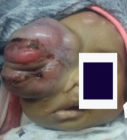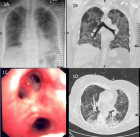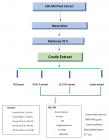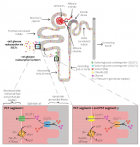About October 6 University
October 6 University
Articles by October 6 University
Evaluation of the antibacterial and anticancer activities of marine Bacillus subtilis ESRAA3010 against different multidrug resistant Enterococci (MDRE) and cancer cell lines
Published on: 28th October, 2020
OCLC Number/Unique Identifier: 8872659898
Fifty nine isolates belonging to six species of Enterococci namely, Enterococcus faecalis, Enterococcus faecium, Enterococcus raffinosus, Enterococcus durans, Enterococcus mundtiiand Enterococcus avium (n = 35, 15, 4, 3, 1 and 1 isolates, respectively) were obtained from different clinical specimens including urine, pus, blood, wound, sputum and synovial fluid. The highest numbers of Enterococci were recorded from the pus (20 isolates, 33.90%) followed by urine (12 isolates, 20.34%) while the lowest frequency was observed with synovial fluid samples (2 isolates, 3.39%). These isolates showed different multidrug resistant patterns with the lowest resistant for linezolid (n = 5, 8.48%), followed by teicoplanin (n = 14, 23.73%) and vancomycin (n = 20, 33.90%) while they exhibited the highest resistant against penicillin (n = 53, 89.83%), oxacillin (n = 50, 84.75%), erythromycin (n = 49, 83.05%) and streptomycin (n = 47, 79.66 %). On the other hand, a free living marine bacterium under isolation code ESRAA3010 was isolated from seawater samples obtained from the fishing area Masturah, Red Sea, Jeddah, Saudi Arabia. The phenotypic, chemotaxonomic, 16S rRNA gene analyses and phylogenetic data proved that isolate ESRAA3010 is very close to Bacillus subtilis and then it was designated as Bacillus subtilis ESRAA3010. It gave the highest antagonistic activity against all clinical Enterococcus faecalis, Enterococcus faecium, Enterococcus raffinosus, Enterococcus durans, Enterococcus mundtiiand Enterococcus avium isolates under study with minimum inhibitory concentration (MIC) ranged from 4 to 56 µg/mL, 4 to 12 µg/mL, 4 to 8 µg/mL, 4 to 8 µg/mL, 8 µg/mL and 4 µg/mL, respectively as well as minimum bactericidal concentration (MBC) (8 to 64 µg/mL, 4 to 16 µg/mL, 4 to 12 µg/mL, 4 to 16 µg/mL, 12 µg/mL and 8 µg/mL, respectively). Moreover it showed anti-proliferative activity against colon (HCT-116), liver (HepG-2), breast (MCF-7) and lung (A-549) carcinomas with IC50 equal to 39, 50, 75 and 19 µg/mL, respectively which indicates its prospective usage in the upcoming decades.
Anticipation of difficulty during laparoscopic cholecystectomy
Published on: 24th July, 2020
OCLC Number/Unique Identifier: 8639116784
Background: Laparoscopic cholecystectomy (LC), is one of the most commonly performed surgical procedures worldwide, it is accepted as the gold standard in the treatment of symptomatic gallstones for its minimal invasiveness, less pain and early recovery.
Purpose: To predict the difficulty of laparoscopic cholecystectomy in patients according to the recently published scoring system and select the difficult cases to be done by a senior surgeon.
Patients: This is a prospective cohort study. This study took place Oct 6th University Hospital and Kasr El Aini Hospital, Cairo university; the study involved 120 patients admitted with calcular cholecystitis, arranged for laparoscopic cholecystectomy.
Methods: Laparoscopic cholecystectomy after applying the scoring system.
Results: In our study we found that age, sex and ultrasonographic data were significant predictive factors for assessment preoperatively difficult cases that will be operated upon. We found 14 patients above 50 years who scored to be difficult and very difficult were at outcome difficult, only three patients converted to open surgery over fifty.
Conclusion: We can report that obese patient who were over fifty with history of previous upper abdominal surgery and ultrasonographic picture showed thick walled GB and pericholecystic collection had high risk of conversion. At this study scoring system was used for prediction of difficult laparoscopic cholecystectomy sensitivity was 93.75% and specificity was 52.94% of the scoring system at score 5 for prediction of easy or difficult laparoscopic cholecystectomy.
Leakage after sleeve gastrectomy: Endoscopic stenting VS surgical intervention
Published on: 24th July, 2020
OCLC Number/Unique Identifier: 8639114108
Background: Laparoscopic sleeve gastrectomy (LSG) is becoming more popular in the treatment of obesity. LSG is safe with a low morbidity. The complications rarely result in morbidity and even mortality. Leaks are the major complication associated with LSG with a reported prevalence between 1.9% and 2.4%.
Objective: To compare surgical intervention and endoscopic stenting for treatment of gastric leakage after sleeve gastrectomy.
Patients and method: Our study included 30 patients presented with post sleeve leaks discovered by routine postoperative imaging or during the follow up period. Patients were recruited from October 6th university hospital during the period from August 2017 to August 2019. Patients were divided to the following groups: 1) Endoscopy group: This included 15 patients with post sleeve leakage undergoing endoscopic stent insertion. 2) Surgery group: which included 15 patients with post sleeve leak age undergoing surgical management. This division was random.
Results: Our study showed that Endoscopic stenting for management of post sleeve gastrectomy leakage is an effective method with lower morbidity and shorter post-operative hospital stay than surgical management. Some patients may be good candidates for early surgical intervention in type 1 leakage if managed early before dissemination of leakage and before tissues become friable. Complications of stents include stent migration (26%), stent related ulcer (13%) and stricture (13%). while the surgical intervention carries more complications (DVT, chest infection, wound infection and stricture) and longer postoperative hospital stay.
Conclusion: endoscopic management of post-sleeve gastrectomy leakage with stenting is recommended because it successfully manages the leaks and avoids invasive procedures with less risk, with shorter hospital stay and early return of function.

HSPI: We're glad you're here. Please click "create a new Query" if you are a new visitor to our website and need further information from us.
If you are already a member of our network and need to keep track of any developments regarding a question you have already submitted, click "take me to my Query."


















































































































































